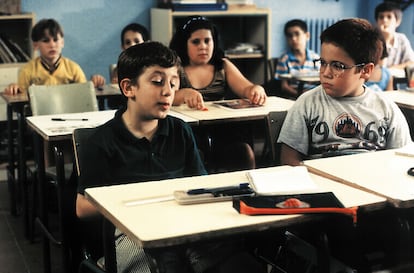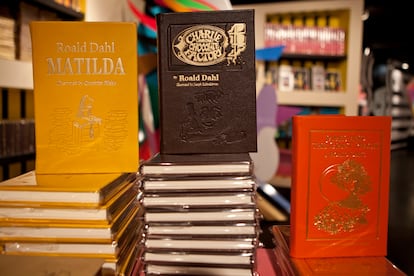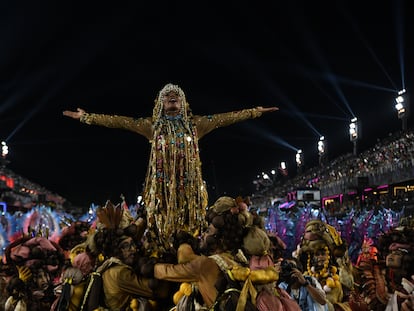Roald Dahl’s rage and humor
Good children’s literature must have something transgressive and subversive to make young readers feel that they are entering terrain that is truly their own

Hallelujah! At last there is kickback against the censorship that too often curtails children’s literature. I can assure you that the issue is of such little interest in the world of culture that it has taken tinkering with a literary giant like Roald Dahl to make some in the industry throw their hands up. If novels for adults were subjected to the same scrutiny, we would be right in concluding there existed a lack of complete creative freedom in the West.
But, let’s be fair and put the matter in perspective: stories have been versioned since the first anthologies began to be published. We would have to go back to Pentamerone, a 17th-century Neapolitan fairytale collection compiled by Italian poet Giambattista Basile, which was tweaked in the 19th century by the Grimm brothers before finally being caramelized into Disney movies. If you were to read the first version of the girl who inspired Sleeping Beauty, you would find a comatose young woman who is raped and impregnated with twins by a passing king. The twins born to the raped woman are on the point of being cooked for the girl’s father.
It is obvious that as much as we defend the exposure of children to this kind of tale, Pentamerone survives as an extraordinary and exclusive volume for adults interested in their concise rawness, defined by Italo Calvino as “the dream of a Neapolitan Shakespeare.”
But there came a time when children’s stories were detached from the oral tradition to become a purely literary creation and that is where, despite the importance they have in the development of children’s imaginations, they do not usually attract the attention they deserve, except when it comes to subjecting them to the perverse mechanism of moral censorship. Those of us who have experienced being translated into numerous languages can understand there have to be some amendments due to cultural differences or the subtle change of an era, and even propose a change in phrase or expression ourselves. But the truth is that good children’s literature must have something transgressive, subversive and absolutely not pedagogical, so that children feel that they are entering a domain that is entirely their own.
It has been many years since a handful of overprotective experts condemned witches to be good, wolves to be kind and the ugly duckling not to transform into a swan so that the reader would not perceive the ending as an unacceptable victory of beauty. Some radical animalists have long had their eye on the old fables because they abhor the anthropocentric vision with which the character of animals is defined. As it is, I am convinced that it would be very difficult for me now to publish the Manolito Gafotas books which deal with a child who speaks with the innocence and self-confidence of his peers, and who for that very reason has been accused in the United States of a thousand surprising sins, such as inciting bullying. Fortunately, I now have the book safe and sound in a collection for adults.

Every author is indebted to their imagination and is a product of their time, even if they are dedicated to the genre of fantasy. When we read literature we must learn that some of the just causes we defend today did not trigger the same kind of solidarity in the past. The adventure novel is full of colonial ambition, misogyny and cruel mockery of the weak, not to mention revenge. The mockery of physical appearance is frequent. This is not to say that this is the most interesting aspect of the classics; they merely echo the social sentiment of an era. In my opinion, the most transgressive aspect of Roald Dahl is not the uncensored descriptions, but a continuous rebellion against adult authority, something that is undoubtedly a relief to the mind of any youngster, allowing it to free itself for a while from the impositions that determine the path of its development.
Inclusion is up to each and every one of us, without the need for catechisms. To think that children’s literature is a manual of good behavior is to disrespect the astute reader who is able to distil the essence of the text. They know immediately if the author is on their side. At least for as long as it takes to read a book, we want to be free of conventions and constraints. What would become of Pippi Longstocking if we were not made aware from the get-go that she is an orphan. What would Dahl be without that cutting sarcasm that no doubt developed during torturous years at an English boarding school away from a mother he thought he felt closer to when he looked out the window. Poor boy. The rage and humor in his stories had their origins in that era as a tool for survival.
Sign up for our weekly newsletter to get more English-language news coverage from EL PAÍS USA Edition
Tu suscripción se está usando en otro dispositivo
¿Quieres añadir otro usuario a tu suscripción?
Si continúas leyendo en este dispositivo, no se podrá leer en el otro.
FlechaTu suscripción se está usando en otro dispositivo y solo puedes acceder a EL PAÍS desde un dispositivo a la vez.
Si quieres compartir tu cuenta, cambia tu suscripción a la modalidad Premium, así podrás añadir otro usuario. Cada uno accederá con su propia cuenta de email, lo que os permitirá personalizar vuestra experiencia en EL PAÍS.
¿Tienes una suscripción de empresa? Accede aquí para contratar más cuentas.
En el caso de no saber quién está usando tu cuenta, te recomendamos cambiar tu contraseña aquí.
Si decides continuar compartiendo tu cuenta, este mensaje se mostrará en tu dispositivo y en el de la otra persona que está usando tu cuenta de forma indefinida, afectando a tu experiencia de lectura. Puedes consultar aquí los términos y condiciones de la suscripción digital.
More information
Archived In
Últimas noticias
Most viewed
- Reinhard Genzel, Nobel laureate in physics: ‘One-minute videos will never give you the truth’
- Oona Chaplin: ‘I told James Cameron that I was living in a treehouse and starting a permaculture project with a friend’
- Pablo Escobar’s hippos: A serious environmental problem, 40 years on
- Why we lost the habit of sleeping in two segments and how that changed our sense of time
- Chevy Chase, the beloved comedian who was a monster off camera: ‘Not everyone hated him, just the people who’ve worked with him’











































